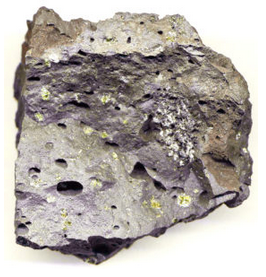6.2.2: Volatiles
- Page ID
- 18726

Magmas may also contain gases, liquids, or vapors, collectively called volatiles. H2O and CO2 are the most common volatiles, but volatile compounds of sulfur, chlorine, and several other elements may also be present. Sometimes, these compounds separate from a melt to form bubbles, most commonly in cooling lava, creating empty vesicles as the magma solidifies.
Figure 6.14 shows a basalt from Hawaii with vesicles (remnants of gas bubbles) up to several millimeters across. This rock contains green crystals of olivine, but most of it is dark colored volcanic glass. The specimen also contains a piece of black and white gabbro that was plucked from the lower crust as the magma rose to the surface. Often, vesicles like those seen in this photo become filled with secondary zeolites or other minerals over time.

Water is especially important during eruptions because just a small amount of water can produce large amounts of steam that lead to violent eruptions. This is especially true for silicic magmas. The explosive May 18, 1980 eruption of Mt. Saint Helens in Washington is an example. A series of earthquakes and small eruptions began at Mt. Saint Helens in March, 1980. A bulge developed on the mountain’s north side and grew for two months as magma moved upward. On May 18, an earthquake caused the north slope to slide away and gas-powered semi-molten magma exploded out of the volcano’s side. The eruption produced a column of ash that rose 24 km into the sky. Ash was deposited in a dozen states and two Canadian provinces. Nearly 60 people were killed by what some people call “the most disastrous volcanic eruption in U.S. history.” The photo in Figure 6.15 shows one of many smaller steam eruptions that preceded the main event.


